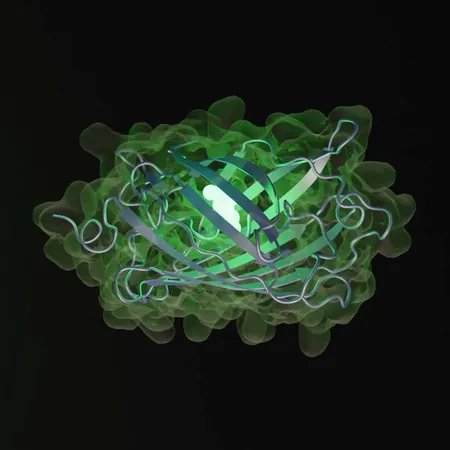
AI Revolutionizes Evolution: Uncovering New Pathways for Artificial Fluorescent Proteins!
2025-01-20
Author: Sophie
Introduction
In a groundbreaking study recently published in the prestigious journal Science, scientists have launched a revolutionary AI experiment simulating 500 million years of evolution. This innovation not only challenges our understanding of evolutionary pathways but also unveils new potential for creating artificial fluorescent proteins that nature never explored. Could this technology change the way we approach biology and disease treatment?
Debate on Evolution
For decades, evolutionary biologist Stephen Jay Gould has sparked debates about the nature of evolution: Was the emergence of humanity inevitable, or merely a fortunate accident? In his famed book Wonderful Life, Gould theorized that if the "tape" of evolution could be rewound and replayed, we might see a completely different outcome, one without modern humans. His arguments highlight how small, seemingly insignificant events can drastically alter the course of evolution, a theme echoed in Ray Bradbury's science fiction classic, A Sound of Thunder.
AI and Evolutionary Experimentation
The introduction of artificial intelligence into evolutionary experimentation opens an exciting frontier. A new company called EvolutionaryScale, founded by ex-researchers from Meta, has developed an advanced AI model named EvolutionaryScale Model 3 (ESM3). Unlike traditional AI, which processes text, ESM3 is engineered to generate biological data—specifically, proteins, the essential building blocks of life. Trained on an astonishing dataset consisting of 771 billion sequences, foundations, and functional traits, ESM3 represents a monumental leap in biological computation, harnessing over one trillion teraflops of processing power.
The Vision
"We envision a future where AI serves as a creative assistant in biological design, just as it does in engineering fields," emphasized Alexander Rives, co-founder and chief scientist at EvolutionaryScale. By interpreting the genetic code—the language of proteins—ESM3 is set to revolutionize how researchers approach protein design.
The Challenge
In this latest study, researchers challenged ESM3 to create a new variant of green fluorescent protein (GFP). GFP is a vital tool in biological research, first identified in jellyfish, and is widely used for tagging and visualization techniques in cells. The AI-generated variant, dubbed esmGFP, showcased only 58% similarity to existing fluorescent proteins. This glimpse into "what could have been" illuminates a path of evolution that could reshape how scientists understand protein function and potential.
Significance of Findings
"This discovery opens doors to proteins that might have existed in the past but didn't make it due to the unique evolutionary history on Earth," noted Rives. The research underscores that even slight mutations in these proteins can dramatically influence their functions, particularly fluorescence.
Community Response
Prominent evolutionary biologists, like Jonathan Losos from the University of Washington and Zachary Blount from Michigan State University, laud the significance of these findings. They assert that this study illustrates missed evolutionary opportunities, supporting the enduring debate between contingency and determinism. While Blount acknowledges that fully reversing evolution remains a daunting challenge, he is optimistic about AI's role in revealing previously uncharted biological pathways.
Conclusion
As the scientific community gains access to ESM3, the implications are vast. Beyond the realm of fluorescent proteins, this AI may pave the way for breakthroughs in therapies for diseases, improvements in environmental solutions, and even new biotechnological applications. The potential of AI in evolutionary biology is just beginning to unfold, and the excitement surrounding these developments suggests we are on the cusp of a new era in science.
Keep an eye on the horizon—this fusion of technology and biology could lead to revolutionary changes in how we understand and manipulate life itself!









 Brasil (PT)
Brasil (PT)
 Canada (EN)
Canada (EN)
 Chile (ES)
Chile (ES)
 Česko (CS)
Česko (CS)
 대한민국 (KO)
대한민국 (KO)
 España (ES)
España (ES)
 France (FR)
France (FR)
 Hong Kong (EN)
Hong Kong (EN)
 Italia (IT)
Italia (IT)
 日本 (JA)
日本 (JA)
 Magyarország (HU)
Magyarország (HU)
 Norge (NO)
Norge (NO)
 Polska (PL)
Polska (PL)
 Schweiz (DE)
Schweiz (DE)
 Singapore (EN)
Singapore (EN)
 Sverige (SV)
Sverige (SV)
 Suomi (FI)
Suomi (FI)
 Türkiye (TR)
Türkiye (TR)
 الإمارات العربية المتحدة (AR)
الإمارات العربية المتحدة (AR)